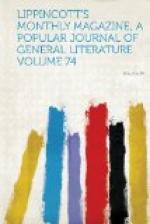Of other statues we shall take another occasion to speak. The tinkle of fountains leads us on to Horticultural Hall, where they give life and charm to the flowers. Painted thus in water-colors, the blossoms and leaves of the tropics glow with a freshness quite wonderful in view of the very short time the plants have been in place and the exposure they unavoidably encountered in reaching it. From the interior and exterior galleries of this exquisite structure one can look down, on one side, upon the palms of the Equator and on the other upon the beech and the fir, which interlock their topmost sprays at his feet. Beyond and beneath the silvery beeches railway-trains whisk back and forth, like hares athwart the covert—the tireless locomotive another foil to the strangers from the land of languor and repose.
[Illustration: HORTICULTURAL HALL—INTERIOR.]
The manufacture of a torrid climate on so large a scale will strike the visitor as one of the most curious triumphs of ingenuity in the whole exposition. Moisture is an essential only second in importance to heat. The two must be associated to create the normal atmosphere of most of the vegetation of the central zone. Art, in securing that end, reverses the process of Nature. The heat here is supplied from below and moisture from above, thus transposing the sun and the swamp. In summer, indeed, the sun of our locality, reinforced by glass, will as a rule furnish an ample supply of warmth. Very frequently it will be in excess, and allow the imprisoned strangers the luxury of all the fresh air they can crave. Our summer climate is in this way more favorable than that of Kew, which in turn has the advantage in winter. The inferior amount of light throughout the year and the long nights of winter in a high latitude again operate against the English horticulturists, and leave, altogether, a balance in our favor which ought to make the leading American conservatory the most successful in the world.
Standing by the marble fountain in the great hall, with its attendant vases and statuary, the visitor will not suspect that the pavement beneath his feet is underlaid by four miles of iron pipe four inches in diameter and weighing nearly three hundred tons. Through this immense arterial and venous system circulates the life-blood of the plants, hot water being the vehicle of warmth in winter. These invisible streams will flow when the brooks at the foot of the hill are sealed by frost and the plash of the open-air fountains is heard no longer.
Another current, more conspicuous and abounding—that of hurrying human feet—will make this magnificent conservatory the centre of one of its principal eddies. A second will be the Japanese head-quarters, and a third Memorial Hall. The outlandish and the beautiful in Nature and in art take chief hold of our interest. It wanders elsewhere, but reverts to what typifies the novel and the charming. From the Mongols




